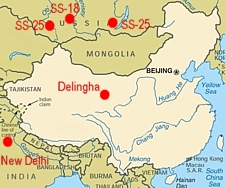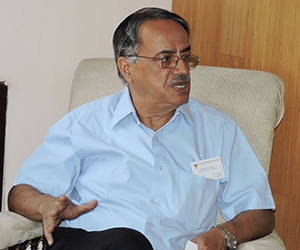In the second week of June PLA conducted an exercise with live fire practice for their anti-tank units in Tibet to test their precision strike capabilities. This training exercise was a sequel to a major live-fire air attack drill conducted in March, by a brigade under the Tibet Military District which in turn is part of the Chengdu Military Region. Evidently the training exercise was aimed at encouraging the PLA troops to have confidence in their weapon systems and their own skills. It also needs to be noted that in recent times the frequency of PLA’s training exercises in Tibet have increased. Further, there is an emphasis on jointness and integration among the PLA Air Force and various arms and services of the PLA.
Earlier in October 2011 two other joint exercises were carried out in Chengdu Military Region and Lanzhou Military Region. The Chengdu Military Region and PLAAF air bases in Tibet are earmarked for operations against Indian targets. The level of the joint exercises was at the Group Army level with the objective of practicing a Division sized force in an integrated and joint environment that involved armour, artillery and PLAAF units of Tibetan plateau. Network centric operations in intense electromagnetic environment i.e. in conditions of ‘informationalisation’ were practiced.
Later, in March this year PLAAF practiced ground attacks in conjunction with army and artillery units. It has also been revealed that PLAAF has modified its J-10 fighter aircrafts to operate in the higher altitudes of Tibet which severely restricts its performance in many operational parameters. Tibetan plateau in winters is freezing cold when it becomes difficult for the PLAAF jet fighters to fly therefore usually it had been exercising in favourable weather conditions of summer. This exercise was also aimed at testing out the new improvements and modifications made to their jet fighters and associated equipment to operate in sub-zero temperatures. The degree of advantage enjoyed by India because the PLA jets have to take off from 10,000 to 12,000 feet high airfield (thus with less payload) would be narrowed. Further, PLAAF is modernising rapidly and the air fleet size is almost triple of our Air Force fleet.
There are also reports that Second Artillery Corps has upgraded its missiles in the Western region by replacing old Dong Feng -3 missiles with intermediate range Dong Feng-21 ballistic missiles. Further with its centrally located missile base at Delingha it can target the Indian capital. And with its new improved logistics infrastructure, especially the railway network in place, the DF-21 missiles from Delingha and elsewhere can be inducted into the central and southern Tibet in a shorter span of time.
It has also been reported that underground missile silos/sites have been constructed in the Tibetan plateau that can strike targets further afield in India or for that matter even into the Indian Ocean. Reports suggest that a modified DF-21 has been converted into an Anti-Ship Ballistic Missile and it has reached an advanced stage of operationalisation. The short range missiles of 200-600 Kms could also be easily moved by road and deployed near the Indian borders to target India’s military and civil installations and other vital areas and vital points.

Added to the above is PLA’s stress on its doctrine of fighting Local Wars under informationalised’ Conditions; this concept was first articulated in China’s National Defence White Paper of 2004. Thereafter, PLA has laid solid foundations for fighting information and cyber wars. Thus, before any physical operations take place it would be the information and cyber domains which would be used to cripple the adversary’s capabilities. PLA’s expanding capabilities in the use of space for military purposes provides it with the means to enhance its command and control, intelligence, surveillance, reconnaissance, information and cyber warfare capabilities.
The PLA formations in Tibet have been provided with additional fire power, precision and long range capabilities. Their organisational structures have also been streamlined.
Further, the PLA has understood that their strategy of active defence depends largely upon achieving a high level of joint capabilities. Their concept of War Zone Campaign aims at the use of “elite and sharp arms” (special operations troops and their wherewithal) to be inserted behind enemy lines and seizing important ground to make a political statement (gaining initiative by striking first remains the essential lynchpin of its active defence strategy). If political objectives are achieved, then the forces are withdrawn, otherwise a quick battle is to be fought to force a quick resolution.
WZC is likely to be conducted at an intermediate level between the theatre and operational levels. It would be a joint and integrated campaign conducted under joint HQs with support from the Military Regions. At some level, WZC which involves the use of rapid reaction forces (RRF) can be compared with our “cold start doctrine” which aims at achieving allotted mission in a short span of time with Integrated Battle Groups. Both concepts are greatly dependent upon ushering in elements of the RMA and the practice of a high level of jointmanship.
What needs to be noticed is that PLA is sharpening its claws in Tibet in concert with increasing number of incursions or so called ‘transgressions’ of PLA across the Line of Actual Control. This stance of assertive PLA in Tibet has been made possible by the massive build up of logistic structure in Tibet to include extensive railway network and over 58,000 kilometres of roads. The roads have been built up to Indian borders and have also penetrated Nepal. This would ensure smooth induction of the PLA troops in any contingency. Not only that, China has initiated diplomatic talks with Bhutan to come understanding with the tiny kingdom on the border issue. If the influence of China on Bhutan increases then it would open another avenue of approach to India in certain contingencies.
PLA’s rising capabilities combined with enhanced levels of jointness and integration in the PLA need to be looked at seriously by India’s politico-military decision-makers.
No doubt India has recently embarked on activating its old airfields along Sino-Indian border and the MOD has chalked out a plan for building extensive road net work and other infrastructure facilities but our record in implementing plans and projects has so far been very tardy.
Further, standards of integration and jointness in our armed forces leave much to be desired. Even though Naresh Chandra’s Task Force in their recent report has recommended the institution of the post of a Chairman Joint Chiefs of Staff, it nevertheless is a climb down from the Chief of Defence Staff recommended earlier by a Group of Ministers in 2001. HQ Integrated Defence Staff created for enhancing jointness and integration does not have adequate powers or wherewithal to enforce jointness or integration.
We also need to pay attention to increasing military assets in the space for enhancing our C4ISR capabilities. Surveillance and radar cover on our Northern borders is weak and needs augmentation at the earliest. And lastly, RMA in our armed forces has been proceeding at a glacial pace given the prevailing politico-bureaucratic environment. All this is leading to widening of the capability gap between the PLA and our armed forces. One thing which needs to be remembered is that weakness invites aggression.
Published Date: 6th July 2012









Post new comment